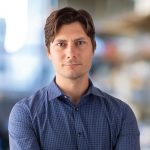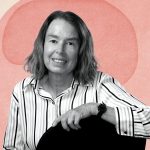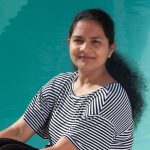OBSERVATIONS Dmitry Lyumkis A Passion for Problem Solving
When asked to name a scientist he admires, Assistant Professor Dmitry Lyumkis struggles to choose just one; he admires so many for different reasons. Eventually he goes with Charles Darwin, citing his “meticulous attention to detail, his ability to simplify and interconnect complex data, of course, his pioneering work, and his love for the natural world.” After an interview with Lyumkis, who answered questions roadside during a break from his bike ride home along San Diego’s Mission Bay, it’s clear why Darwin stood out.
Inside Salk chatted with Lyumkis about his science and his own methodical approach to the process.
Can you talk about why you became a scientist?
I’ve known that I wanted to be in research for a long time because I just enjoy being in the lab. I enjoy the process of discovery, which is kind of a tedious process really, because the discovery aspect happens so rarely. But when it does happen, it’s really neat. I’ve considered many other paths, but none of them really stuck.
As a chemistry undergraduate at UC San Diego, I worked with a graduate student on the total synthesis of a natural product called Bielschowskysin. This is a very complex molecule that has shown antimalarial and anticancer activity, and to this day chemists have not been able to make this molecule in the lab. This project got me interested in chemistry, chemical reactions and experimental research. Eventually, I began taking biochemistry courses and learning about larger molecules like proteins and protein assemblies. I did my PhD work at the Scripps Research Institute and afterwards came to Salk as a fellow and then as an assistant professor.
I see it as a very logical transition from chemistry, going from small molecules to larger macromolecules, to macromolecular assemblies, and putting them all together to try to understand how they work inside a cell.
Speaking of other paths, in a TEDx talk a few years ago, you mentioned a brief stint studying philosophy in college. Did that experience inform how you approach science?
I think in both fields you have to be curious and open-minded. You always have to question what you’re studying and question the data. Don’t get too stuck on an idea. The idea could be wrong, and if you test the idea—essentially your hypothesis—you might find something quite unexpected.
What’s your favorite part of the scientific process?
I love looking at new data; everyone does, especially if that data is telling you something interesting. I must admit I do very much like the troubleshooting aspect, basically working through a problem and trying to find the right approach. I think if you don’t, then science is a very tough career trajectory.
Let’s talk about the work you’re doing now. What does your lab study?
My lab is a structural biology lab. That means that we determine the atomic structures of proteins and protein assemblies that are responsible for a variety of molecular processes, and we use the structural insights, together with biochemical experiments, to understand how they function. The majority of the work in the lab focuses on protein assemblies that functionally interact with chromatin, which is the material inside a cell that packages your DNA.
For example, one of the processes that we’re interested in is called retroviral integration. It’s the process by which retroviruses, like HIV, gain access to the genome of a host cell—which is packaged into chromatin—and insert their own viral DNA into the host DNA to establish a permanent infection in that target cell. What we try to do is isolate, purify, and determine the structures of the proteins involved in this process, and how exactly they engage the chromatin assemblies. Then we can create 3D models of those molecular processes to understand the biology. For example in this particular case, we want to understand how viral DNA is integrated into the genome and why certain regions are selected. These models often also act as blueprints for designing small molecules that can potentially be developed into therapeutics. We have an ongoing project in the lab to understand how small molecules bind to and inhibit the integration process, and also the mechanisms by which the virus evolves resistance against therapeutic treatment strategies.
The other projects in the lab have a similar theme but are focused more on other cellular events surrounding chromatin, with implications in cancer and other diseases.
Your lab uses cryo-electron microscopy (cryo-EM), an imaging technique that won the 2017 Nobel Prize in Chemistry. What makes this method so powerful?
There are a few things: First, this approach doesn’t require as much biological sample as you would need for other, more traditional structural biology approaches, like X-ray crystallography. Second, the sample does not have to take the form of a crystal, which right away dramatically expands the types of questions that you can ask and the types of proteins or protein assemblies that you can study.
The third, and I’d say most exciting feature, is that it allows you to understand complex protein assemblies. Because cryo-EM lets you interpret many different states of protein assemblies, it gives you a much more dynamic representation of how they move, and by extension, how they function. You simply cannot study those types of assemblies using crystallographic methods.
Is there a specific discovery or moment in lab that you’re particularly proud of?
A few years ago, we developed a new method for collecting cryo-EM data that turned out to be important and gave rise to a lot of new ideas. It was really fulfilling because we had a simple idea at the spur of the moment, and it turned out to be very useful.
We were trying to collect cryo-EM data, but we couldn’t collect good data, due to the way in which the specimen was oriented on our support grids. So we had the very simple idea to basically tilt the stage inside the microscope.
People have thought about doing this before, but it never worked because there were a lot of practical problems. In many ways, ours was an engineering effort. We were able to solve prior issues, and the tilting worked, which gave us much better data. We ended up building upon the idea slowly but methodically, and now a large portion of the field is using our tools. What was really interesting from a scientific perspective, was that the approach also generated a number of new directions in my own lab, which I think are equally, if not more important, and address fundamental theoretical concerns in the cryo-EM field. For example, working with tilted data made us look deeper into the question of how do cryo-EM images lead to a good 3D reconstruction of the imaged protein specimen. We found that the way in which we evaluate our reconstructed cryo-EM maps was inadequate, and we need to take into account an additional factor to properly describe the object. This has direct implications for how we evaluate resolution in cryo-EM. It can all be explained mathematically and appears to line up with experiments. That was a real discovery, and it continues to generate new ideas. So that’s neat. Such moments don’t happen very often, but I like when they do.
What do you find unique about conducting research at Salk?
Being at Salk gives you a wide appreciation of the types of questions that people are interested in and the scientific challenges outside of your immediate field. And occasionally, that leads to productive and fruitful collaborations that you might not have found anywhere else. My lab has a couple of those kinds of collaborations. We worked with Patrick Hsu, and we determined atomic structures of the novel CRISPR/Cas13d enzymes that he discovered while he was a fellow at Salk. The structures, together with biochemical data, gave us a good understanding of what the enzymes were doing and provided insights into how they could be modified and used for ongoing genetic engineering efforts in Patrick’s lab. We are now starting an exciting project with Joe Noel, where we are trying to isolate the chromatin assemblies that my own lab has been studying for multiple years. In my lab, we’re studying the mammalian forms of these protein assemblies, but with Joe, we are now trying to isolate them from plant cells!
Do you have a favorite spot on Salk’s campus?
The coffee cart. I like coffee and I enjoy having scientific conversations there.
What do you like to do for fun?
I enjoy many outdoor activities. My wife and I really like to hike and camp. Occasionally, we will go mountain biking together or with friends. But, more regularly, I cycle to and from work at least several days a week. This is very refreshing for me mentally and often allows me to think through some problems and ideas. I’m actually awaiting the arrival of my electric bike, which will nicely complement my road bike, and between the two, hopefully will allow me to completely ditch my car and cycle to and from work on a daily basis.
What are you most looking forward to, post-pandemic?
I very much liked the ability to discuss ideas with the people in the lab in person. I’m looking forward to getting a little bit more momentum and getting back into lab.
Support a legacy where cures begin.
Featured Stories
 The aging puzzle comes togetherAging is a complex puzzle, but by applying a collaborative, multidisciplinary approach, Salk scientists are putting its many pieces together.
The aging puzzle comes togetherAging is a complex puzzle, but by applying a collaborative, multidisciplinary approach, Salk scientists are putting its many pieces together. Dmitry Lyumkis – A passion for problem solvingAssistant Professor Dmitry Lyumkis discusses what he loves about data and the scientific process, and which places inspire him outside the lab.
Dmitry Lyumkis – A passion for problem solvingAssistant Professor Dmitry Lyumkis discusses what he loves about data and the scientific process, and which places inspire him outside the lab.
 Pamela Maher – Seeking treatments for Alzheimer’s diseaseFrom having a large garden to investigating compounds that plants make, Staff Scientist Pam Maher talks about how plants inspire her to find treatments for Alzheimer’s disease.
Pamela Maher – Seeking treatments for Alzheimer’s diseaseFrom having a large garden to investigating compounds that plants make, Staff Scientist Pam Maher talks about how plants inspire her to find treatments for Alzheimer’s disease. Rajasree Kalagiri – Bound to phosphohistidineRajasree Kalagiri shares the serendipitous steps along her journey of scientific discovery from southern India to Southern California.
Rajasree Kalagiri – Bound to phosphohistidineRajasree Kalagiri shares the serendipitous steps along her journey of scientific discovery from southern India to Southern California.


















































